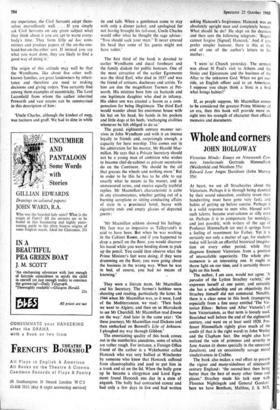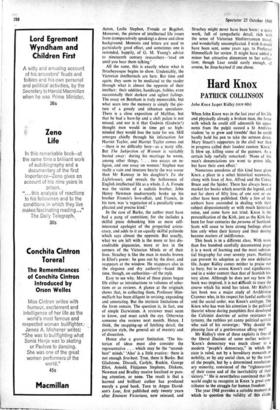Whole and corners
• JOHN HOLLOWAY
Edward Lear Angus Davidson (John Murray 35s) At heart, we are all Stracheyites about the Victorians. Perhaps it is through being daunted by their sound education, assiduity (even their handwriting must have gone very fast), and habits of getting up before sunrise. Perhaps it is a valid response to men who, blessed with such talents, became over-solemn or silly even so. Perhaps it is to compensate for nostalgia, and just possibly, with writers of the age of Professor Himmelfarb (or me) it springs from a feeling of resentment for Father. Yet it is certainly not only a matter of age, for students today will lavish an effortful historical imagina- tion on every other period, while they diagnose Eminent Victorians from a position of unassailable superiority. The whole phe- nomenon is an interesting one. It ought to throw light on our time, and it certainly throws light on this book. The author, I am sure, would not agree. 'A parodist of the Lytton Strachey variety,' she expresses herself at one point; and certainly she has a scholarship and an objectivity that Strachey himself did not command. Notably, there is a clear sense in this book (transpiring especially from a fine essay entitled 'The Vic- torian Ethos: Before and After Victoria') of how Victorianism, as that term is loosely used, flourished well before the end of the eighteenth century, and went on at least until 1920. Pro- fessor Himmelfarb rightly gives much of the credit (if that is the right word) to John Wesley and the Clapham Sect. She might also have noticed the vein of primness and severity in Jane Austen (it shows specially in the unrevised Sanditon), and an occasionally savage moral vindictiveness in Crabbe.
The book also makes a real effort to present the vigour and many-sidedness of nineteenth century England: 'the second-best then being better than the best of many other times and places.' Strachey made his task easy with Florence Nightingale and General Gordon: here we have Bentham, Malthus, J. S. Mill, Acton, Leslie Stephen, Froude or Bagehot. Moreover, the picture of intellectual life issues from (comparatively speaking) a dense and close background. Memoirs and letters are used to particularly good effect, and sometimes one is reminded, happily, of G. M. Young's advice to nineteenth century researchers—'read on until you hear them talking.'
All the same, this is exactly where what is Stracheyesque begins to show. Undeniably, the Victorian intellectuals are here. But time and again, they seem to be mediated to the reader through what is almost the opposite of their intellect : their oddities, handicaps, foibles, even occasionally their darkest and ugliest failings. The essay on Bentham is truly memorable, but what sears into the memory is simply the pic- ture of a greedy and inhuman speculator. There is a close exposition of Malthus, but that he had a hare-lip and a cleft palate is not missed, and nor is it that Godwin (Godwin!) thought men would in time get so high- minded they would lose the taste for sex. Mill emerges chiefly through his infatuation for Harriet Taylor, and Harriet Taylor comes out —there is no difficulty here—as a nasty silly.
But The Subjection of Women is veritably buried away: during his marriage he wrote, among other things, . . two essays on re- ligion, and one essay on women.' Stephen was really a vain and insecure hearty (he was worse than Mr Ramsay in his daughter's To the Lighthouse), and reveals the hollowness of English intellectual life as a whole. J. A. Froude was the victim of a sadistic brother, John Henry Newman inadvertently broke up his brother Francis's love-affair, and Francis, in his turn, was 'a vegetarian of a peculiarly com- plicated and precise kind.'
In the case of Burke, the author must have had a pang of contrition; for she includes a skilful piece debunking him as mere self- interested apologist of the propertied aristo- cracy, and adds to it an equally skilful palinode which says almost the opposite. But usually, what we are left with is the more or less dis- creditable piquancies, more or less in the corners of the Victorian Minds or of their lives. Strachey is like the man in mocha brown in Eliot's poem: he goes out by the door, and reappears at the window. He reappears also in the elegance and dry authority—based this time, though, on authorities—of the style.
Easy to see why. Most of these pieces began life either as introductions to volumes of selec- tions or as reviews. A glance at the originals shows that, in collecting them, Professor Him- melfarb has been diligent in revising, expanding and annotating. But the intrinsic limitations of the form remain. The question is, in fact, one of simple Darwinism. A reviewer must seem to know, and must catch the eye. Otherwise someone else reviews next month. Hence, I think, the snapping-up of fetching detail, the patrician style, the general air of mastery and of dissection.
Hence also a graver limitation. The his- torian of ideas must also consider the representative . . . which may be the "second- best" minds.' Also' is a little evasive: there is not enough first-best. True, there is Burke. But Gladstone, Disraeli, Carlyle, Ruskin, George Eliot, Arnold, Fitzjames Stephens, Dickens, Newman and Bradley receive localised or pass- ing attention, or none. The result is that a learned and brilliant author has produced merely a good book. Turn to Angus David- son's Lear, first published only twenty years after Eminent Victorians, now reissued, and
Strachey might never have been born : a quiet work, full of sympathetic detail, rich with the sense of Victorian Mediterranean travel, and wonderfully uncomplicated. I wish it could have been sent, some years ago, to Professor Himmelfarb for review. It might have added a minor but attractive dimension to her collec- tion; though Lear could easily enough, of course, be Stracheyised if one chose.















































 Previous page
Previous page